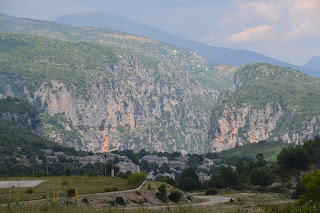Gabor Lövei
The 2015 Greek Summer School in Conservation Biology started
with a pre-course refresher in the R program, held by a new trainer, Zoltan
Elek from Hungary. Four participants chose to arrive early, and take two days,
Saturday and Sunday, to look at the basics of the now prominent (and free)
statistical program, R.
Three more participants and the other lecturers arrived on
Sunday to a rainy, cloudy Ioannina – which was a very strange experience. On
all previous years of the GSS, raincoats have hardly been used at all – now it
was heavy rain, with dark grey clouds and temperatures resembling northern
Germany rather than northern Greece.
This year we have 7 participants, three Italian (Giancarlo,
Eddy, Marlene), one Greek (Kostas), one Turkish (Nihal), and two German
(Esther, Frank) students. We have had a high number of last-minute
cancellations, and we were wondering if this was anything to do with the
political and financial uncertainty in Greece. Opinions are divided; and Greeks
themselves seem also divided on how to progress.
However, this has no consequences for the Summer School, and
we got off to a start on Monday. The lectures were opened by a talk on
ecosystem services (by Gabor), followed by an introduction by Kalliope Stara on
the sacred groves and veteran trees of the region. After lunch, we set off on a
walk to the nearby village of Monodendri. As a change from last year when a
false turn lead the participants into the thicket of prickly oak (Quercus coccifera), we decided to walk
the other way, from Ano Pedina to Monodendri. We set off in light rain, tasting
the fruit of the mulberry and cherry trees along the steep slope of the main
street of Ano Pedina. We saw that a bear must have visited the village, and
eating mulberries and cherries, leaving behind a scat full of seeds.
Platanus
orientalis tree planted near the village church – the huge tree was planted
in 1819, and its trunk engulfed the memorial plaque commemorating the date –
which is just visible now through a ”window” (see photo in the left). From here we climbed
the hillside up to the St. Paraskevi monastery – miraculously saved when the
whole forest above the village burned in 2000. We have found a few late orchids
(Himantoglossum caprinum, Cephalanthera
rubra), and mushrooms.
From here, the path lead up to the top of the
mountain, providing us with splendid views of the giant dolinas that form the
valley between Ano Pedina and Kato Pedina, two villages on the two opposing
hillsides. Kalliope lead us to see the abandoned monastery of Prophet Elias, in
Vitza near Monodendri, with some old maple trees, but we got an ugly shock when
we went around, to see the oldest oak tree of the Zagori mountains. The soil
from around the veteran oak was removed, the surrounding trees cut to allow the
passing of a bulldozer that then flattened an area around a small church
building, pouring a lot of cement and a paved terrace around a group of hornbeam
trees. So, welcome to conservation reality – Kalliope immediately got out her
phone, and a campaign started. Apparently, no one had authorisation to do this work,
and the forest service knew nothing about it. Now they do, and hopefully some
action can be taken to save the old oak and lessen the damage to the landscape.
Stay tuned – we shall try to send updates as the course
progresses.



No comments:
Post a Comment